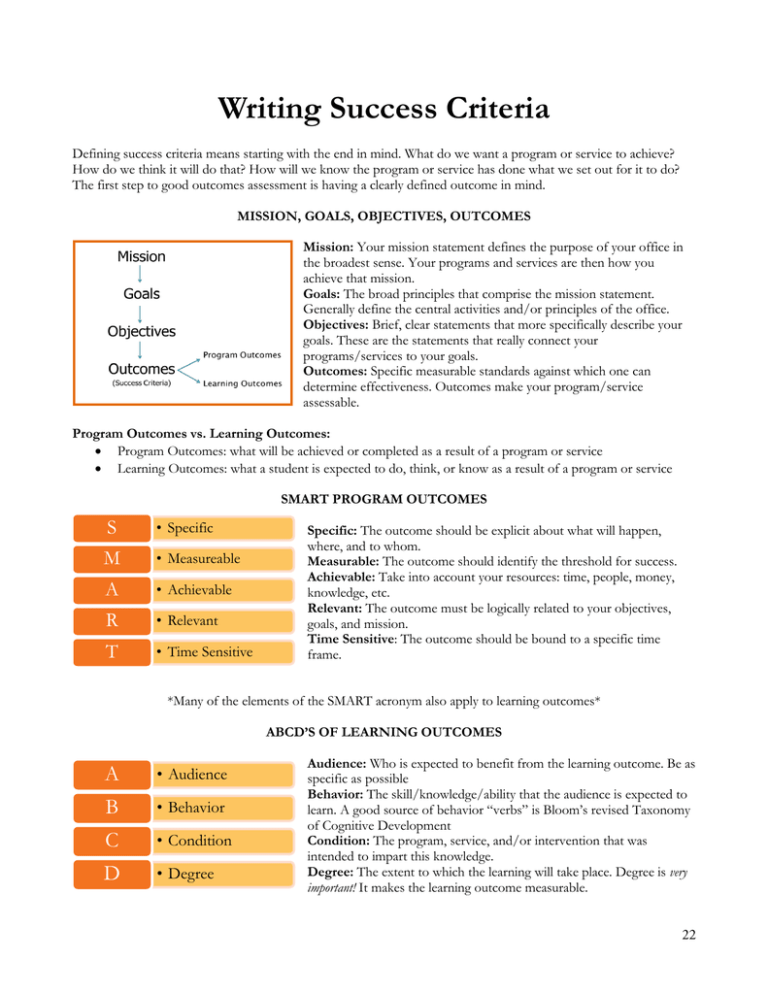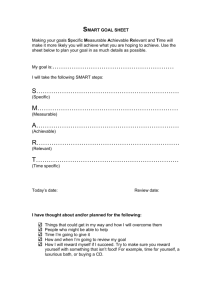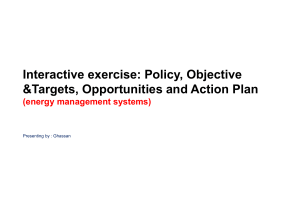Writing Success Criteria
advertisement

Writing Success Criteria Defining success criteria means starting with the end in mind. What do we want a program or service to achieve? How do we think it will do that? How will we know the program or service has done what we set out for it to do? The first step to good outcomes assessment is having a clearly defined outcome in mind. MISSION, GOALS, OBJECTIVES, OUTCOMES Mission: Your mission statement defines the purpose of your office in the broadest sense. Your programs and services are then how you achieve that mission. Goals: The broad principles that comprise the mission statement. Generally define the central activities and/or principles of the office. Objectives: Brief, clear statements that more specifically describe your goals. These are the statements that really connect your programs/services to your goals. Outcomes: Specific measurable standards against which one can determine effectiveness. Outcomes make your program/service assessable. Program Outcomes vs. Learning Outcomes: Program Outcomes: what will be achieved or completed as a result of a program or service Learning Outcomes: what a student is expected to do, think, or know as a result of a program or service SMART PROGRAM OUTCOMES S • Specific M • Measureable A • Achievable R • Relevant T • Time Sensitive Specific: The outcome should be explicit about what will happen, where, and to whom. Measurable: The outcome should identify the threshold for success. Achievable: Take into account your resources: time, people, money, knowledge, etc. Relevant: The outcome must be logically related to your objectives, goals, and mission. Time Sensitive: The outcome should be bound to a specific time frame. *Many of the elements of the SMART acronym also apply to learning outcomes* ABCD’S OF LEARNING OUTCOMES A • Audience B • Behavior C • Condition D • Degree Audience: Who is expected to benefit from the learning outcome. Be as specific as possible Behavior: The skill/knowledge/ability that the audience is expected to learn. A good source of behavior “verbs” is Bloom’s revised Taxonomy of Cognitive Development Condition: The program, service, and/or intervention that was intended to impart this knowledge. Degree: The extent to which the learning will take place. Degree is very important! It makes the learning outcome measurable. WRITING OUTCOMES Don’t make it harder than it has to be! – Pretend it is a game of Mad Libs and just plug in the appropriate information. Make sure the information is as specific as possible. Avoid double-barreled outcomes. If the learning/program outcome has an “AND” in it, chances are it should be split into two outcomes! This makes it easier to report your results. How would you report your progress if you achieved one part of the outcome but not the other? If at all possible, write your learning outcomes so they are measuring a behavior and not a thought or belief. It will be much easier to assess! o For example, it is much easier to assess “Students who attend the information session will be able to explain how to register for Greek recruitment” than it is to assess “Students who attend the information session will know how to register for Greek recruitment.” They measure essentially the same thing, but the behavior-based learning outcome is much easier to assess. Limit the number of outcomes per program/service. There is no magic number for which to aim, but consider what the central focus of the program or service is. Instead of having 5 outcomes for one event, try to identify the 1-2 key outcomes that are the most important. By focusing, you will be able to spend more time assessing them and will do a better job overall with your assessment! Assessment Mapping Assessment mapping provides a visual representation of the alignment process. A mapping document shows how your learning/administrative goals or outcomes link to your department programs and services. Maps can be created at a variety levels and at different points in the assessment planning process. MAPPING USES Identify opportunities for learning Identify gaps Aligns strategies with outcomes Make learning expectations transparent Illustrate how the curriculum, co-curriculum, and extra-curriculum are integrated to promote holistic student learning and development Identify points of assessment STEPS TO CREATING AN ASSESSMENT MAP Keep it simple- simple maps can be expanded as the process becomes more complex, you might begin with a specific program or a department Articulate your outcomes (left column) Describe how your program is delivering those outcomes (programs, project, workshop – list across the top) Diagram or map which activity is delivering or producing each intended outcomes (check the box) Determine if the activities, workshops, and/or projects are useful and appropriate in achieving the stated outcome (look for gaps)

